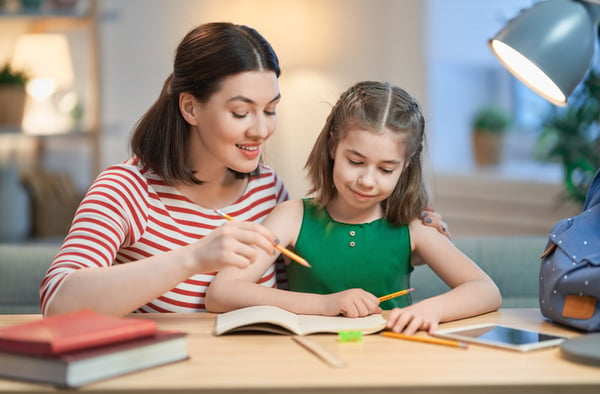
COVID-19 has brought change—and challenges—to education. The Vision Therapy Center wants to help.
Because 80% of all learning occurs visually, there are basic vision-based strategies you can execute at home to help you do the following:
- Create an ideal learning environment.
- Keep your kids on track and working efficiently.
- Stay organized and help everyone in the process.
Below, we provide tips to help with these three critical areas. The information is based on insights from both developmental optometrists and educators.
1. Create an Ideal Learning Environment
The kitchen table or the breakfast bar may be okay for 10 or 15 minutes of schoolwork. But children learning at home really need a good learning environment, including a desk or table and a chair that are appropriate for their size.
The primary goals for an ideal learning environment are to:
- Create comfort.
- Reduce physical fatigue.
- Enable better productivity for a longer period of time.
So, before you turn on the computer, crack the books, and help your child settle into another day of school at home, pause and step back. Consider crucial factors like these:
Feet. Dangling feet won’t cut it. Both feet should be flat on the floor. You want your child comfortable and secure in their chair.
Hips and knees. Both should bend at 90 degree angles (like in the diagram below).

Image courtesy of Visual Edge
Viewing distance from eyes to work surface. The optimal distance for reading, called Harmon’s Distance, is the space from the middle knuckle to the elbow, measured from the chin.
Note: If this distance is difficult to maintain for your child (for example, if they’re continually leaning in), this could be a sign that they have a functional vision problem, that they need prescription eyewear, or both.
A slanted surface. A laptop or notebook computer screen can be positioned to make it easier to see. But a book or paper notebook is a different story. Ideally, items like these should be propped up at an angle.
You may want to consider a slant board (pictured below). Alternatively, you can use an empty three-ring binder or a recipe book board. 
Working on a slanted surface is extremely important. The most comfortable angle for reading is when the material is parallel to the face. (Note the yellow lines demonstrating this in the diagram up above.)
But when the material is flat on the table, a person will lean forward and turn their head downward to achieve this angle. That’s a problem because now they are no longer sitting up straight and, due to gravity, it becomes more difficult to maintain Harmon's Distance (discussed in the point above).
Lighting. We recommend using full spectrum lighting. Also, your child shouldn't be able to see the light source's reflection on the screen.
Remember that a computer shouldn’t be the sole source of light. It’s important to have ambient lighting in the room to facilitate awareness of visual space around and beyond the computer.
Looking out. Make sure your child can look out into the distance—e.g., a window—for visual breaks.
Note that having plenty of space around and beyond the work area allows for your child to easily take visual breaks by focusing on something in the distance for 10 seconds every 10 minutes. More on this point below.
Eyes and head. Both eyes should be the same distance from the screen. If your child tends to tilt and/or turn their head or rest their face on one hand, this can interfere with efficient eye teaming and focusing.
A multitude of other potential factors. Stay open and observant to how your child may be affected—positively or negatively—by the following factors, which is by no means an exhaustive list:
- Room temperature
- Music
- The color of the room
- Hydration
- Diet
- Exercise
- Aromas
- Amount and quality of sleep

2. Keep Your Kids on Track and Working Efficiently
In conjunction with the tips above, you can help create a better learning situation and reduce your child’s visual stress with these techniques:
Take consistent visual breaks. To reduce eye fatigue, every 10 minutes have your child look at a distant object about 20 feet away for 10 seconds.
Intersperse physical movement breaks. To help maintain good focus, your child should take a break for at least five minutes every hour. Have them get up and move around. See more on breaks below.
Plan activities for breaks and make sure they have set boundaries and specific goals. For example:
- Making a certain number of basketball shots.
- Jumping a certain number of times on the trampoline.
- Catching the ball a certain number of times.
- Playing bean bags for a set amount of time.
- Running around the outside of the house or yard a certain number of times.
Incorporate time management skills. By the time we’re adults, most of us learn to judge time relatively accurately. But children don’t necessarily understand time the way we do.
But there are things to do to help them, which is especially important if you’re trying to get your child to gradually manage more of their own time schedule. Here are a few examples:
- Use a stopwatch or clock and ask how long 30 seconds is, two minutes is, etc. and see how accurate their estimates are.
- Time simple activities and compare your child’s estimate to how long it actually took (like tying shoes, setting the table, brushing teeth, etc.).
- At different points in each day, ask your child what time it is to increase their awareness of the passing of time.
3. Encourage Good Organization to Help Everyone Stay on Task
Take steps to create effective organization. Being organized is obviously crucial for learning.
Keep these tips in mind as you try to help your child stay organized and stick to an effective work schedule:
- Work together to set a schedule.
- Be open to how your child tries to be organized. It may seem quirky to you, but it may work best for them.
- Ask them to describe what they do to stay organized and have them explain why they think it works for them.
- Present options for being organized and let your child choose.
- After each day, encourage them to evaluate how well their schedule went. Get them to articulate what they think went well and what didn't.
- Celebrate success and find constructive ways to improve on things that didn’t go so well.
- Break down daily tasks into manageable parts. Start small with your child’s favorite activities and gradually add more as they become accustomed to this modified form of learning.
Help encourage a positive attitude and create an emotionally healthy environment—for everyone involved. Your role as a home teacher isn’t an easy one, so try not to get frustrated.
Here are some things to remember that can help you and your child:
- A happy and calm child is more ready to learn. Remember to smile and laugh a lot.
- Keep the focus on the positive. For example, “You got 8 out of 10 correct!” is better than “You got two wrong.”
- Be flexible and remember you know your child best. For instance, maybe your child really benefits from sleeping until 9 a.m.
- When possible, give them ownership. Ask them, “What do you think will work best for you to do this task?”
- Give them a special area and a box or basket where all of their learning supplies are kept.
When you help your child in these ways, you’ll also help yourself!
Check Out These Additional Resources
For more details on the ideas presented above, check out our webinar How to Help Kids School-at-Home More Effectively.
We also have a special offer for parents who’d like to do a home-study consultation with us (via Zoom video). That means we’ll assess your child’s workspace and study habits to help you create an optimized game plan for learning at home.
Learn more about our Home-Study Consultation!

